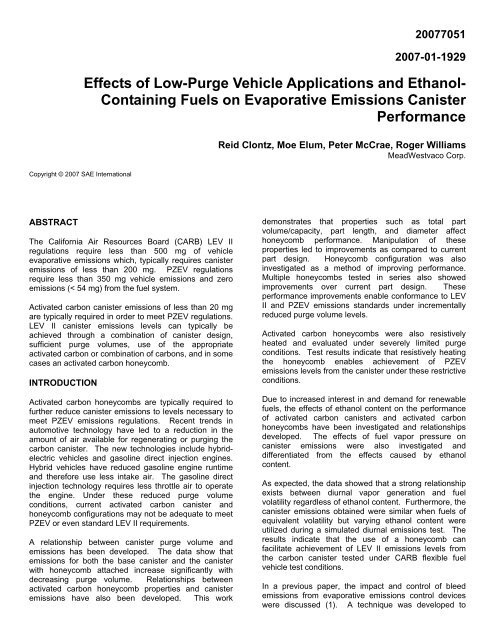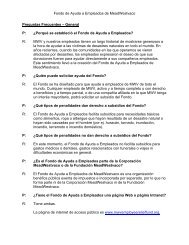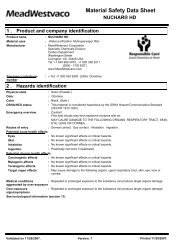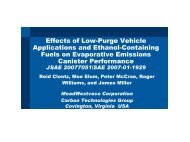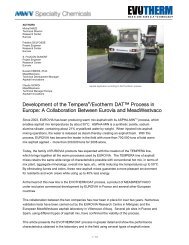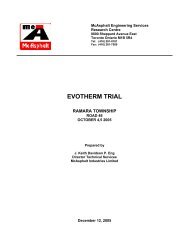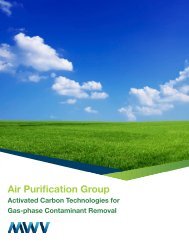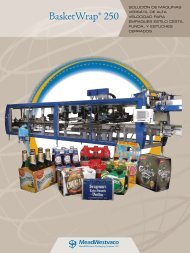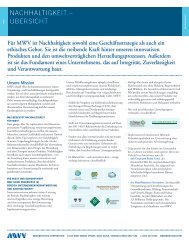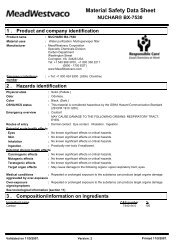Effects of Low-Purge Vehicle Applications and ... - MeadWestvaco
Effects of Low-Purge Vehicle Applications and ... - MeadWestvaco
Effects of Low-Purge Vehicle Applications and ... - MeadWestvaco
You also want an ePaper? Increase the reach of your titles
YUMPU automatically turns print PDFs into web optimized ePapers that Google loves.
Copyright © 2007 SAE International<br />
ABSTRACT<br />
20077051<br />
2007-01-1929<br />
<strong>Effects</strong> <strong>of</strong> <strong>Low</strong>-<strong>Purge</strong> <strong>Vehicle</strong> <strong>Applications</strong> <strong>and</strong> Ethanol-<br />
Containing Fuels on Evaporative Emissions Canister<br />
Performance<br />
The California Air Resources Board (CARB) LEV II<br />
regulations require less than 500 mg <strong>of</strong> vehicle<br />
evaporative emissions which, typically requires canister<br />
emissions <strong>of</strong> less than 200 mg. PZEV regulations<br />
require less than 350 mg vehicle emissions <strong>and</strong> zero<br />
emissions (< 54 mg) from the fuel system.<br />
Activated carbon canister emissions <strong>of</strong> less than 20 mg<br />
are typically required in order to meet PZEV regulations.<br />
LEV II canister emissions levels can typically be<br />
achieved through a combination <strong>of</strong> canister design,<br />
sufficient purge volumes, use <strong>of</strong> the appropriate<br />
activated carbon or combination <strong>of</strong> carbons, <strong>and</strong> in some<br />
cases an activated carbon honeycomb.<br />
INTRODUCTION<br />
Activated carbon honeycombs are typically required to<br />
further reduce canister emissions to levels necessary to<br />
meet PZEV emissions regulations. Recent trends in<br />
automotive technology have led to a reduction in the<br />
amount <strong>of</strong> air available for regenerating or purging the<br />
carbon canister. The new technologies include hybridelectric<br />
vehicles <strong>and</strong> gasoline direct injection engines.<br />
Hybrid vehicles have reduced gasoline engine runtime<br />
<strong>and</strong> therefore use less intake air. The gasoline direct<br />
injection technology requires less throttle air to operate<br />
the engine. Under these reduced purge volume<br />
conditions, current activated carbon canister <strong>and</strong><br />
honeycomb configurations may not be adequate to meet<br />
PZEV or even st<strong>and</strong>ard LEV II requirements.<br />
A relationship between canister purge volume <strong>and</strong><br />
emissions has been developed. The data show that<br />
emissions for both the base canister <strong>and</strong> the canister<br />
with honeycomb attached increase significantly with<br />
decreasing purge volume. Relationships between<br />
activated carbon honeycomb properties <strong>and</strong> canister<br />
emissions have also been developed. This work<br />
Reid Clontz, Moe Elum, Peter McCrae, Roger Williams<br />
<strong>MeadWestvaco</strong> Corp.<br />
demonstrates that properties such as total part<br />
volume/capacity, part length, <strong>and</strong> diameter affect<br />
honeycomb performance. Manipulation <strong>of</strong> these<br />
properties led to improvements as compared to current<br />
part design. Honeycomb configuration was also<br />
investigated as a method <strong>of</strong> improving performance.<br />
Multiple honeycombs tested in series also showed<br />
improvements over current part design. These<br />
performance improvements enable conformance to LEV<br />
II <strong>and</strong> PZEV emissions st<strong>and</strong>ards under incrementally<br />
reduced purge volume levels.<br />
Activated carbon honeycombs were also resistively<br />
heated <strong>and</strong> evaluated under severely limited purge<br />
conditions. Test results indicate that resistively heating<br />
the honeycomb enables achievement <strong>of</strong> PZEV<br />
emissions levels from the canister under these restrictive<br />
conditions.<br />
Due to increased interest in <strong>and</strong> dem<strong>and</strong> for renewable<br />
fuels, the effects <strong>of</strong> ethanol content on the performance<br />
<strong>of</strong> activated carbon canisters <strong>and</strong> activated carbon<br />
honeycombs have been investigated <strong>and</strong> relationships<br />
developed. The effects <strong>of</strong> fuel vapor pressure on<br />
canister emissions were also investigated <strong>and</strong><br />
differentiated from the effects caused by ethanol<br />
content.<br />
As expected, the data showed that a strong relationship<br />
exists between diurnal vapor generation <strong>and</strong> fuel<br />
volatility regardless <strong>of</strong> ethanol content. Furthermore, the<br />
canister emissions obtained were similar when fuels <strong>of</strong><br />
equivalent volatility but varying ethanol content were<br />
utilized during a simulated diurnal emissions test. The<br />
results indicate that the use <strong>of</strong> a honeycomb can<br />
facilitate achievement <strong>of</strong> LEV II emissions levels from<br />
the carbon canister tested under CARB flexible fuel<br />
vehicle test conditions.<br />
In a previous paper, the impact <strong>and</strong> control <strong>of</strong> bleed<br />
emissions from evaporative emissions control devices<br />
were discussed (1). A technique was developed to
study the level <strong>of</strong> bleed emissions specifically from<br />
canister vent ports. Carbon type, canister design <strong>and</strong><br />
purge volume were shown to have a significant impact<br />
on bleed emissions. Further, the incorporation <strong>of</strong> a<br />
small auxiliary chamber in series with the primary<br />
canister was shown to decrease bleed emissions<br />
significantly (1).<br />
Activated carbon honeycombs, typically incorporated as<br />
separate auxiliary chambers, are currently being<br />
successfully used to meet LEV II <strong>and</strong> PZEV regulations<br />
in many vehicles. This technology has been shown to<br />
be an effective means to control bleed emissions,<br />
particularly in systems where large purge volumes are<br />
not available.<br />
Recent trends in vehicle technology have created<br />
questions concerning the performance <strong>of</strong> the<br />
evaporative emissions control canister system. <strong>Vehicle</strong><br />
technologies such as hybrid powertrains, direct fuel<br />
injection, variable engine displacement, <strong>and</strong><br />
homogeneous charge compression engine technology<br />
can have a significant impact on canister performance<br />
due to reduced volumes <strong>of</strong> air available for canister<br />
purge.<br />
In addition to new developments in power-train<br />
technology, increased interest in renewable fuels such<br />
as ethanol have also led to questions concerning the<br />
performance <strong>of</strong> activated carbon <strong>and</strong> activated carbon<br />
honeycombs.<br />
It should be noted that canister design can have a<br />
significant impact on evaporative emissions. The<br />
baseline canister used in this study was not a design<br />
optimized to control bleed emissions. Thus, the<br />
emissions results should primarily be taken on a relative<br />
basis. The purpose <strong>of</strong> this paper was not to investigate<br />
the effect <strong>of</strong> base canister design, but to optimize the<br />
use <strong>of</strong> the activated carbon honeycomb under reduced<br />
purge conditions <strong>and</strong> under conditions <strong>of</strong> exposure to<br />
fuels <strong>of</strong> different volatility <strong>and</strong> ethanol content.<br />
EXPERIMENTAL METHODS<br />
Bleed emissions were evaluated using a laboratory test<br />
method involving an initial canister gasoline preconditioning,<br />
butane load, purge followed by a timecontrolled<br />
soak, <strong>and</strong> emissions measurement during a<br />
final canister vapor load simulating a diurnal loading<br />
event.<br />
The canisters used for testing purposes were all the<br />
same design <strong>and</strong> contained 2.1 liters <strong>of</strong> BAX 1500<br />
carbon. The canisters were used multiple times for<br />
repeat testing. To ensure fuel blending was not a<br />
concern, each canister was cycled with the appropriate<br />
fuel unitl equilibrium was reached.<br />
GASOLINE VAPOR AND BUTANE CYCLING<br />
Gasoline vapor cycling was performed using automated<br />
cycle test equipment that precisely controlled <strong>and</strong><br />
monitored all testing conditions. Gasoline vapors were<br />
generated by bubbling air at a rate <strong>of</strong> 200 cc/min through<br />
2 liters <strong>of</strong> certified test fuel heated to 36°C. For<br />
example, a 62.1 RVP-certified test gasoline typically<br />
resulted in a vapor generation rate <strong>of</strong> approximately 40<br />
g/hr with a hydrocarbon concentration <strong>of</strong> approximately<br />
50% by volume. The generated vapors were sent to the<br />
canister until a breakthrough concentration <strong>of</strong> 5000 ppm<br />
was detected using a flame ionization detector (FID). If<br />
breakthrough was not detected after 90 minutes <strong>of</strong> vapor<br />
loading, the liquid gasoline was replaced with a fresh 2liter<br />
aliquot. After breakthrough was detected, the<br />
canister was purged for a specified volume, typically 400<br />
bed volumes, using dry air at a rate <strong>of</strong> 22.7 liters per<br />
minute. The dwell time between load <strong>and</strong> purge events<br />
was no more than 5 minutes. The ambient temperature<br />
<strong>of</strong> the equipment, including the canister storage<br />
compartment, was maintained at 20°C during all stages<br />
<strong>of</strong> the testing.<br />
DIURNAL TESTS<br />
The diurnal test procedure, referred to as the simulated<br />
real-time diurnal test, was used to subject a fuel tank<br />
<strong>and</strong> canister to the CARB diurnal temperature pr<strong>of</strong>ile<br />
within a temperature-controlled environmental chamber.<br />
This test procedure was published previously (1). The<br />
test was designed to simulate the diurnal portion <strong>of</strong> the<br />
CARB vehicle emissions test procedure in order to<br />
generate quantitative emissions data isolated to only the<br />
evaporative emissions canister.<br />
Pre-conditioning for the simulated real-time diurnal test<br />
included multiple gasoline vapor load <strong>and</strong> purge cycles<br />
as described above. Following the gasoline cycles, the<br />
canister was loaded with 50% butane vapor at a load<br />
rate <strong>of</strong> 40 g/hr to a 5000 ppm breakthrough as measured<br />
by an in-line flame ionization detector in preparation for<br />
a two-day diurnal test. After the butane load, the<br />
canister was allowed to soak for 60 minutes before<br />
purging with a specified volume <strong>of</strong> air. Following the<br />
purge, the canister was soaked at 20°C for 24 hours<br />
before starting the diurnal test.<br />
After the 24-hour soak, the canister was attached to a<br />
commercial 60-liter steel fuel tank containing 24 liters<br />
(40% fill) <strong>of</strong> the certified test fuel specified. The fuel<br />
temperature was equilibrated to 18.3 °C overnight before<br />
beginning the test. A Tedlar® bag was attached to the<br />
atmosphere port <strong>of</strong> the canister as shown in Figure 1 to<br />
collect the hydrocarbon emissions. During the 11-hour<br />
temperature ramp from 18.3° C to 40.6° C, the canister<br />
weight <strong>and</strong> emissions were measured several times.<br />
During the portion <strong>of</strong> the diurnal when the temperature<br />
decreased, the Tedlar® bag was removed in order to<br />
allow the system to back purge.<br />
During each emissions measurement, the Tedlar® bag<br />
was removed <strong>and</strong> filled to a known volume with nitrogen.
The hydrocarbon concentration was determined by<br />
evacuation <strong>of</strong> the bag contents into a flame ionization<br />
detector. Once the concentration <strong>and</strong> volume were<br />
determined, the mass <strong>of</strong> hydrocarbon was calculated<br />
<strong>and</strong> recorded. The total test procedure incorporating<br />
gasoline aging <strong>and</strong> diurnal testing takes approximately<br />
one <strong>and</strong> a half weeks per canister test. Due to time<br />
considerations, only a limited number <strong>of</strong> repeat tests<br />
were performed. Where possible repeats were<br />
performed <strong>and</strong> the nominal test value was reported.<br />
The entire two-day CARB diurnal temperature pr<strong>of</strong>ile<br />
was used for canister purge volumes <strong>of</strong> 75 bed volumes<br />
or greater. Figure 2 represents the CARB temperature<br />
pr<strong>of</strong>ile used for the environmental chamber containing<br />
the test canister. It should be noted that canister design<br />
can have a significant impact on evaporative emissions.<br />
The purpose <strong>of</strong> this paper was not to investigate the<br />
effect <strong>of</strong> base canister design, but to optimize the use <strong>of</strong><br />
the activated carbon honeycomb under reduced purge<br />
conditions. All <strong>of</strong> the testing was performed with a<br />
commercial 2.1-liter carbon canister filled with BAX 1500<br />
automotive grade carbon.<br />
RESISTIVELY HEATED ACTIVATED CARBON<br />
HONEYCOMB<br />
An activated carbon honeycomb was prepared for<br />
resistive heating by attaching electrodes to the<br />
honeycomb using conductive epoxy. Electrical current<br />
was passed through the part using a constant 12-volt<br />
power supply. Electrical current was applied only while<br />
the canister was being purged.<br />
ETHANOL FUEL BLENDS<br />
In order to determine the effect <strong>of</strong> ethanol content <strong>and</strong><br />
fuel vapor pressure on canister emissions, fuels with a<br />
range <strong>of</strong> ethanol content <strong>and</strong> volatility were evaluated<br />
<strong>and</strong> are listed in Table 1.<br />
Test<br />
Fuel - #<br />
RVP<br />
(kPa) @<br />
37.8 o C<br />
1 34.5<br />
2 48.3<br />
3 48.3<br />
4 55.2<br />
5 62.1<br />
6 62.1<br />
Fuel Product<br />
Code<br />
Haltermann -<br />
HF032<br />
Haltermann -<br />
HF087<br />
Haltermann -<br />
HF004<br />
Haltermann -<br />
HF087 <strong>and</strong> 40<br />
CFR 86.1313-04<br />
(FFV)<br />
40 CFR 86.1313-<br />
04<br />
Haltermann -<br />
HF115<br />
Ethanol<br />
Volumetric<br />
Concentratio<br />
n (%)<br />
85<br />
85<br />
0<br />
10<br />
0<br />
10<br />
Table 1. List <strong>of</strong> fuels used to perform diurnal testing.<br />
Tedlar Bag<br />
Environmental Chamber<br />
Canister 60-Liter Fuel Tank<br />
Figure 1. Diagram <strong>of</strong> simulated CARB diurnal<br />
evaporative emissions test.<br />
Temperature ( o C) .<br />
45<br />
40<br />
35<br />
30<br />
25<br />
20<br />
15<br />
10<br />
5<br />
0<br />
0 3 6 9 12 15 18 21 24<br />
Time (hr)<br />
Figure 2. Diagram <strong>of</strong> CARB Diurnal Temperature Pr<strong>of</strong>ile.<br />
RESULTS AND DISCUSSION<br />
Previously published results showed that canister<br />
evaporative emissions can be controlled by utilizing<br />
high-capacity/low-heel wood-based carbons, optimizing<br />
canister geometry, using an auxiliary chamber, <strong>and</strong><br />
increasing purge volume available to the canister (1).<br />
This paper concerns the further optimization <strong>of</strong> bleed<br />
control under conditions <strong>of</strong> reduced purge <strong>and</strong> also<br />
describes results obtained with ethanol containing fuels.<br />
EFFECT OF PURGE VOLUME ON CANISTER<br />
EMISSIONS<br />
The two-day simulated real time diurnal test was used to<br />
evaluate the effect <strong>of</strong> purge volume on canister<br />
hydrocarbon emissions. Each test involved<br />
preconditioning <strong>of</strong> a 2.1-liter canister as described above<br />
in preparation for the simulated diurnal test. In addition<br />
to evaluating base canister performance, canisters were<br />
evaluated with activated carbon honeycombs attached<br />
to the vent port <strong>of</strong> the canister. The activated carbon<br />
honeycombs are high-carbon content monoliths
specifically designed to reduce canister emissions. Two<br />
commercially available activated carbon honeycomb<br />
parts were evaluated. Dimensions for these two<br />
cylindrical parts are 29 mm diameter x 100 mm length<br />
<strong>and</strong> 41 mm diameter x 150 mm length. Both parts had a<br />
nominal cell density <strong>of</strong> 200 cpsi. In order to evaluate the<br />
effect <strong>of</strong> purge volume, the final purge volume before the<br />
24-hour soak <strong>and</strong> subsequent diurnal test was varied<br />
from 200 bed volumes to 75 bed volumes. The purge<br />
time was kept constant at 21 minutes, while the purge<br />
rate was changed in order to achieve the desired purge<br />
volume. The test results are shown in Figure 3.<br />
Day 2 Emissions (mg) .<br />
500<br />
450<br />
400<br />
350<br />
300<br />
250<br />
200<br />
150<br />
100<br />
50<br />
0<br />
Base Canister<br />
29x100-200<br />
41x150-200<br />
75 100 150 200<br />
Bed Volumes <strong>of</strong> <strong>Purge</strong><br />
Figure 3. Effect <strong>of</strong> <strong>Purge</strong> volume with base canister <strong>and</strong><br />
commercially available honeycombs.<br />
The data in Figure 3 demonstrates the strong<br />
relationship between purge volume <strong>and</strong> canister<br />
emissions. The activated carbon honeycombs<br />
significantly reduced canister emissions with purge<br />
volumes <strong>of</strong> 100 bed volumes <strong>and</strong> greater. In addition,<br />
the larger 41 mm x 150 mm honeycomb exhibited lower<br />
emissions levels than the 29 mm x 100 mm honeycomb<br />
at purge volumes <strong>of</strong> less than 200 bed volumes. Due to<br />
the strong relationship between purge volume <strong>and</strong><br />
emissions, as purge volume is decreased, emissions<br />
increase. As a result, there is a point for each <strong>of</strong> the<br />
commercially available carbon honeycombs at which<br />
purge volume will be insufficient to meet either PZEV or<br />
LEV II emissions targets.<br />
OPTIMIZATION OF CARBON HONEYCOMB<br />
PROPERTIES FOR LOW PURGE VOLUME<br />
APPLICATIONS<br />
Alternative Honeycomb Geometry<br />
The commercially available activated carbon<br />
honeycombs evaluated with low levels <strong>of</strong> purge (
Honeycomb Configuration B (three 41x50 parts in series<br />
<strong>and</strong> rotated 45°) showed a 32% improvement over the<br />
baseline Configuration A. This performance<br />
improvement is assumed to be the result <strong>of</strong> flow<br />
redistribution <strong>and</strong>/or increased tortuosity <strong>of</strong> the flow path.<br />
Honeycomb Configurations C (41x200) <strong>and</strong> D (50x150)<br />
showed approximately 45% <strong>and</strong> 60% improvement as<br />
compared to the baseline Configuration A. Both <strong>of</strong> these<br />
honeycomb configurations have more total working<br />
capacity due to their larger size as compared to the<br />
baseline honeycomb. In addition, Configuration C has a<br />
longer flow path for vapors diffusing out <strong>of</strong> the main<br />
canister.<br />
Results obtained with Configurations C <strong>and</strong> D confirm<br />
earlier data indicating that increased diffusional flow path<br />
length <strong>and</strong>/or total part capacity have an impact on bleed<br />
emissions (2). This earlier work was performed with 27<br />
mm diameter honeycombs <strong>of</strong> varying length at higher<br />
purge volumes <strong>of</strong> 150 bed volumes. The results from<br />
the earlier work are presented in Figure 5.<br />
Day 2 Emissions (mg) .<br />
200<br />
180<br />
160<br />
140<br />
120<br />
100<br />
80<br />
60<br />
40<br />
20<br />
0<br />
No HCA 50 mm 75 mm<br />
Honeycomb Length<br />
100 mm 150 mm<br />
Figure 5. Results obtained with 27 mm diameter<br />
honeycombs evaluated with 150 bed volumes <strong>of</strong> purge.<br />
The results obtained with the developmental honeycomb<br />
configurations show that the following changes to the<br />
baseline part improve emissions performance.<br />
1. Increased honeycomb working capacity<br />
2. Increased diffusional flow path length<br />
3. Flow redistribution<br />
4. Increased tortuosity<br />
Further work is planned in order to better underst<strong>and</strong> the<br />
reasons for these performance improvements <strong>and</strong> to<br />
develop a honeycomb with more robust performance at<br />
low purge volumes.<br />
Resistive Heating <strong>of</strong> the Honeycomb to Reduce Canister<br />
Emissions<br />
Resistive heating <strong>of</strong> activated carbon honeycombs has<br />
been shown to improve performance over baseline<br />
activated carbon honeycomb performance. This is<br />
particularly effective at low purge volume levels because<br />
an un-heated honeycomb may fail to achieve desired<br />
performance. In order to demonstrate this concept, the<br />
two-day simulated diurnal testing procedure described<br />
earlier was repeated by resistively heating an activated<br />
carbon honeycomb during the preconditioning purge.<br />
This is possible with <strong>MeadWestvaco</strong> activated carbon<br />
honeycombs due to their electrical properties. The<br />
electrical conditions <strong>and</strong> temperatures achieved during<br />
the purge cycles are summarized in Table 4 followed by<br />
a summary <strong>of</strong> the results in Figure 6.<br />
HCA Size<br />
Heated HCA Configuration<br />
41x150-200<br />
<strong>Purge</strong> Air Temp ( o C) 70 - 90<br />
Max HCA Temp ( o C) 200<br />
Current (amps) @ 12v 1.8 -2.2<br />
Table 4. Heated honeycomb conditions during purge<br />
cycle.<br />
Day 2 Emissions (mg) .<br />
180<br />
160<br />
140<br />
120<br />
100<br />
80<br />
60<br />
40<br />
20<br />
0<br />
50 75 100 150 200<br />
Bed Volumes <strong>of</strong> <strong>Purge</strong><br />
Heated 41x150-200<br />
Baseline 41x150-200<br />
Figure 6. Summary <strong>of</strong> emissions results obtained with<br />
heated honeycomb configuration.<br />
Figure 6 shows that emissions measured with the<br />
heated activated carbon honeycomb were lower as<br />
compared to the non-heated honeycomb. The<br />
improvement in performance was most dramatic at lower<br />
purge volumes. Resistively heating the honeycomb<br />
allowed emissions <strong>of</strong> less than 20 mg for all levels <strong>of</strong><br />
purge evaluated. These emissions levels are significant<br />
because they correlate well with performance required<br />
for PZEV compliance on vehicles. The results obtained<br />
with the resistively-heated activated carbon honeycomb<br />
are due to a more complete removal <strong>of</strong> hydrocarbon<br />
heel from both the activated carbon honeycomb <strong>and</strong> the
portion <strong>of</strong> the canister carbon bed closest to the<br />
atmosphere port.<br />
EFFECT OF CARBON HONEYCOMB ON CANISTER<br />
WORKING CAPACITY<br />
As a result <strong>of</strong> testing for canister bleed emissions<br />
performance, it was discovered that activated carbon<br />
honeycombs have a significant positive impact on<br />
diurnal canister working capacity. The effect <strong>of</strong> the<br />
activated carbon honeycomb on canister gasoline<br />
working capacity is summarized in Figure 7.<br />
Canister G W C (g) .<br />
180<br />
160<br />
140<br />
120<br />
100<br />
80<br />
60<br />
40<br />
20<br />
0<br />
+4%<br />
+11%<br />
+13%<br />
+19%<br />
No HCA 29x100-200 41x150-200 50x150-200 Heated<br />
41x150<br />
Figure 7. Effect <strong>of</strong> activated carbon honeycomb on<br />
canister working capacity.<br />
The baseline gasoline working capacity <strong>of</strong> 138 g<br />
presented in Figure 6 was obtained with a 2.1-liter<br />
canister filled with BAX 1500 without an activated carbon<br />
honeycomb attached. An increase in overall canister<br />
working capacity <strong>of</strong> 4% to 19% was demonstrated with<br />
the addition <strong>of</strong> an activated carbon honeycomb. The<br />
increased capacity was proportional to the honeycomb<br />
size <strong>and</strong> therefore the capacity <strong>of</strong> the honeycomb to<br />
adsorb hydrocarbon vapors.<br />
EFFECT OF ETHANOL FUEL BLENDS ON CARBON<br />
BED PERFORMANCE<br />
Adsorption <strong>of</strong> Ethanol<br />
The adsorption <strong>and</strong> desorption isotherms for Ethanol<br />
<strong>and</strong> Butane on BAX 1500 at 25°C, is shown in Figures 8<br />
<strong>and</strong> 9.<br />
Loading g/g Carbon<br />
1.40<br />
1.20<br />
1.00<br />
0.80<br />
0.60<br />
0.40<br />
0.20<br />
Adsorption<br />
Desorption<br />
0.00<br />
10 100 1000 10000 100000 1000000<br />
Concentration (ppm)<br />
Figure 8. BAX 1500 Butane Equilibrium Isotherm.<br />
Loading g/g Carbon<br />
1.40<br />
1.20<br />
1.00<br />
0.80<br />
0.60<br />
0.40<br />
0.20<br />
Adsorption<br />
Desorption<br />
0.00<br />
10 100 1000 10000 100000 1000000<br />
Concentration (ppm)<br />
Figure 9. BAX 1500 Ethanol Equilibrium Isotherm.<br />
Comparisons <strong>of</strong> these figures clearly show that, at equal<br />
concentrations, ethanol is more readily adsorbed than<br />
butane, the st<strong>and</strong>ard used to evaluate automotive<br />
carbons (3, 4). More importantly, due to the<br />
mesoporous nature <strong>of</strong> <strong>MeadWestvaco</strong> automotive<br />
carbons, the desorption curves show that ethanol <strong>and</strong><br />
butane are readily removed from the carbon pores.<br />
Ethanol Fuel Blends<br />
There are two potential ways for ethanol to be present in<br />
fuels:<br />
1. Splash Blending. This is the straight addition <strong>of</strong><br />
alcohol to a non-alcohol-based gasoline. This has been<br />
shown to significantly affect the vapor pressure <strong>of</strong> the<br />
resultant mix as shown in Figure 10 (5).
Reid Vapor Pressure @ 37.8oC (kPa)<br />
.<br />
80<br />
70<br />
60<br />
50<br />
40<br />
30<br />
20<br />
10<br />
0<br />
0 10 20 30 40 50 60 70 80 90 100<br />
Ethanol Concentration (%)<br />
Figure 10: Effect on Vapor Pressure by ethanol addition<br />
to 9.0 RVP Fuel<br />
Figure 10 shows that splash blending <strong>of</strong> ethanol up to<br />
approximately 40% will cause an increase in the vapor<br />
pressure <strong>of</strong> the resultant blend.<br />
2. Blending to a fixed Vapor Pressure. This is the<br />
addition <strong>of</strong> an ethanol to gasoline fuel that has been<br />
altered so that the resultant solution has the same vapor<br />
pressure as the unblended gasoline. For example, in<br />
the case <strong>of</strong> Fuel - 6, the volatility <strong>of</strong> the non-ethanol<br />
components <strong>of</strong> the fuel is reduced to compensate for this<br />
effect <strong>of</strong> adding ethanol.<br />
Regardless <strong>of</strong> the approach used, the most important<br />
property <strong>of</strong> the fuel blend with respect to activated<br />
carbon canister performance is the vapor pressure. The<br />
vapor pressure, rather than ethanol content, determines<br />
the resultant diurnal vapor generation from the fuel tank<br />
<strong>and</strong> therefore the required working capacity <strong>of</strong> the<br />
carbon canister.<br />
Diurnal Vapor Generation<br />
A range <strong>of</strong> fuels was tested for vapor generation rates by<br />
following the diurnal test procedure <strong>of</strong> subjecting a fuel<br />
tank <strong>and</strong> canister to the entire two-day CARB diurnal<br />
temperature pr<strong>of</strong>ile as described earlier. The RVP <strong>of</strong> the<br />
fuels tested ranged from 34.5 to 62.1 kPa, with an<br />
ethanol content <strong>of</strong> 0 to 85%. The diurnal vapor<br />
generation results are shown in Figure 11.<br />
Average Daily Vapor Load (g) .<br />
40<br />
35<br />
30<br />
25<br />
20<br />
15<br />
Fuel - 1<br />
Fuel - 3<br />
Fuel - 4<br />
Fuel - 2<br />
Fuel - 5<br />
10<br />
20 25 30 35 40 45<br />
RVP (kPa)<br />
50 55 60 65 70<br />
Figure 11. Diurnal vapor generation <strong>of</strong> fuels tested<br />
As would be expected, this figure shows a strong<br />
relationship between RVP <strong>and</strong> vapor generation. More<br />
importantly, it shows that fuels <strong>of</strong> equivalent RVP will<br />
generate similar total amounts <strong>of</strong> diurnal vapors<br />
regardless <strong>of</strong> the ethanol content. For example, on the<br />
average Fuel -2 generated 27.5 grams <strong>of</strong> vapor<br />
compared to an average <strong>of</strong> 29.7 grams for Fuel - 3 with<br />
an equivalent RVP. While similar total vapor generation<br />
amounts have been observed for fuels with similar RVP,<br />
it is understood that the fuels may have different<br />
volatilities at the various temperatures experienced<br />
during the CARB diurnal temperature pr<strong>of</strong>ile. Based on<br />
these results, if a canister is properly sized for use with a<br />
62.1 RVP fuel, it should be adequately sized for ethanol<br />
blends <strong>of</strong> an equal or lower RVP.<br />
EFFECT OF ETHANOL FUEL BLENDS ON<br />
HONEYCOMB PERFORMANCE<br />
Initially, simulated diurnal testing was conducted using<br />
st<strong>and</strong>ard Fuel - 5 <strong>and</strong> Fuel - 3 as specified by CARB<br />
procedures for non-Flex Fuel <strong>Vehicle</strong>s (FFV’s) to<br />
establish baseline performance. Results obtained using<br />
the 2.1-liter canister filled with BAX 1500 both with <strong>and</strong><br />
without a st<strong>and</strong>ard 41x150 honeycomb (Configuration A)<br />
attached under these conditions were compared to<br />
those obtained by cycling with the same Fuel - 5<br />
followed by a two day diurnal using Fuel - 2. The results<br />
are compared in Figure 12.<br />
Day 2 Emissions (mg) .<br />
180<br />
160<br />
140<br />
120<br />
100<br />
80<br />
60<br />
40<br />
20<br />
0<br />
BAX 1500 w / 41x150 HCA<br />
BAX 1500<br />
Cyc Fuel - 5 / DBL Fuel - 3 Cyc Fuel - 5 / DBL Fuel - 2
Figure 12. Diurnal emissions for equivalent RVP E0 <strong>and</strong><br />
E85 fuel blends with 150 bed volumes <strong>of</strong> purge.<br />
Figure 12 shows that within the accuracy <strong>of</strong> the testing<br />
(+/- 7.5 mg), use <strong>of</strong> an E85 fuel blend rather than the<br />
st<strong>and</strong>ard CARB Fuel - 3 during the simulated diurnal test<br />
does not have a significant impact on emissions. Based<br />
on this data, bleed emissions appear to be independent<br />
<strong>of</strong> ethanol content for both the main canister <strong>and</strong> the<br />
honeycomb. In addition, the results show that the use <strong>of</strong><br />
a st<strong>and</strong>ard, commercially-available activated carbon<br />
honeycomb (Configuration A) makes it possible to<br />
reduce canister emissions to PZEV levels.<br />
The simulated diurnal testing was repeated by<br />
performing preconditioning cycling with the CARB Fuel -<br />
2 mileage accumulation fuel followed by a diurnal with<br />
the fuel type specified for evaporative emissions testing<br />
<strong>of</strong> flexible fuel vehicles, Fuel - 4. These results were<br />
compared to those obtained when a st<strong>and</strong>ard Fuel - 5<br />
was used for the two-day diurnal test following<br />
preconditioning cycles with Fuel -2 mileage<br />
accumulation fuel. The results are shown in Figure 13.<br />
Day 2 Emissions (mg) .<br />
300<br />
250<br />
200<br />
150<br />
100<br />
50<br />
0<br />
BAX 1500 w / 41x150 HCA<br />
BAX 1500<br />
Cyc Fuel - 2 / DBL Fuel - 4 Cyc Fuel - 2 / DBL Fuel - 5<br />
Figure 13. Diurnal emissions for Fuel - 4 <strong>and</strong> Fuel – 5<br />
with 150 bed volumes <strong>of</strong> purge.<br />
The results provide further evidence that emissions are<br />
independent <strong>of</strong> ethanol content for either the main<br />
canister or the main canister in combination with the<br />
honeycomb. More importantly, the results show that the<br />
use <strong>of</strong> a st<strong>and</strong>ard, commercially available activated<br />
carbon honeycomb (Configuration A) makes it possible<br />
to reduce canister emissions to LEV II levels for FFV’s.<br />
CONCLUSION<br />
Recent trends in automotive technology have led to a<br />
reduction in the amount <strong>of</strong> air available for regenerating<br />
or purging the carbon canister. Under these reduced<br />
purge volume conditions, current activated carbon<br />
canister <strong>and</strong> honeycomb configurations may not be<br />
adequate to meet PZEV or even st<strong>and</strong>ard LEV II<br />
requirements. Improvements over the current<br />
honeycomb technology such as the following facilitate<br />
achievement <strong>of</strong> target emissions levels under the<br />
reduced purge conditions:<br />
• Higher capacity honeycombs<br />
• Longer diffusional path length<br />
• Flow redistribution<br />
• Resistively-heated honeycombs<br />
Further work is planned in order to gain a better<br />
underst<strong>and</strong>ing about the relative importance <strong>of</strong><br />
diffusional flow path length <strong>and</strong> honeycomb capacity.<br />
With regards to trends in renewable fuels <strong>and</strong> in<br />
particular ethanol blends, the following was shown<br />
• <strong>MeadWestvaco</strong> mesoporous automotive<br />
carbons readily adsorb <strong>and</strong> desorb ethanol<br />
• Based on the range <strong>of</strong> fuels tested, ethanol<br />
content does not adversely affect the carbon<br />
canister performance<br />
• Canister emissions are driven primarily by the<br />
fuel volatility rather than ethanol content<br />
• <strong>MeadWestvaco</strong> commercially available<br />
honeycombs can enable FFV’s to attain LEV II<br />
compliance.<br />
ACKNOWLEDGMENTS<br />
The authors wish to express their sincere appreciation to<br />
Joe W. Snead, who aided in the design, operation <strong>and</strong><br />
maintenance <strong>of</strong> the equipment used in the study. Dr.<br />
James R. Miller, who provided support <strong>and</strong><br />
encouragement.<br />
REFERENCES<br />
1. R. S. Williams <strong>and</strong> C. Reid Clontz, “Impact <strong>and</strong><br />
Control <strong>of</strong> Canister Bleed Emissions,” SAE<br />
Technical Paper 2001-01-0733, March 2001.<br />
2. R. S. Williams, <strong>MeadWestvaco</strong>, Evaporative<br />
Emissions Seminar, 2002.<br />
3. Annual Book <strong>of</strong> ASTM St<strong>and</strong>ards 2006, Volume<br />
15.01, ASTM International, ISBN 0-8031-4224-2,<br />
West Conshohocken, PA.<br />
4. H. R. Johnson <strong>and</strong> R. S. Williams, “Performance <strong>of</strong><br />
Activated Carbon Canisters in Evaporative Loss<br />
Control Systems,“ SAE Technical Paper 902119,<br />
October 1990.<br />
5. Robert L. Furey, “Volatility Characteristics <strong>of</strong><br />
Gasoline-Alcohol <strong>and</strong> Gasoline-Ether Fuel Blends,”<br />
SAE Technical Paper 852116.<br />
CONTACT
<strong>MeadWestvaco</strong> Specialty Chemicals Division<br />
P.O. Box 140, Washington Street<br />
Covington, VA 24426<br />
800-336-2211<br />
DEFINITIONS, ACRONYMS, ABBREVIATIONS<br />
BAX 1500: 2mm pelletized MWV automotive carbon<br />
with an ASTM BWC <strong>of</strong> 14.8 g/dl minimum<br />
Bed Volumes: Volume <strong>of</strong> air used to purge the canister<br />
divided by volume <strong>of</strong> carbon in main canister volume<br />
excluding volume <strong>of</strong> honeycomb<br />
CARB: California Air Resources Board<br />
CPSI: Nominal cells per square inch<br />
Cyc: Abbreviation for “cycled” for simulated driving<br />
cycles used to precondition evaporative emission<br />
canister<br />
DBL: Diurnal Bleed Loss<br />
E-10S: Splash Blended Fuel using 62.1 RVP (E0) <strong>and</strong><br />
pure ethanol to 10% Ethanol Concentration, uncontrolled<br />
vapor pressure<br />
E85: 85% ethanol blend<br />
FFV 10%: “Flex Fuel <strong>Vehicle</strong> 10%,” Fuel blended to<br />
10% ethanol concentration using 48.3 RVP E-85 <strong>and</strong><br />
62.1 RVP (E0)<br />
GWC: Gasoline Working Capacity<br />
HCA: Hydrocarbon Adsorber or Honeycomb<br />
LEV: <strong>Low</strong> Emission <strong>Vehicle</strong><br />
PZEV: Partial Zero Emission <strong>Vehicle</strong><br />
RVP: Reid Vapor Pressure at 37.8°C (kPa)<br />
SHED: Sealed Housing Evaporative Determination<br />
Tedlar® : DuPont’s registered Polyvinyl Fluoride<br />
products that are chemically inert


